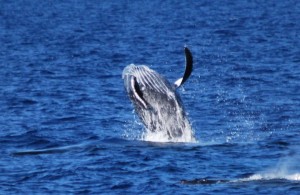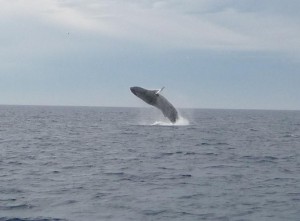Aloha,
Tag Archives: Mom/Baby/Escort
Spinners and Humpbacks Swim Together
Monday morning brought us some windy conditions at Anaeho’omalu Bay, but guests joining us on Seasmoke’s Wake up With the Whales got to see some pretty fun surface activity. Throughout the two hours, we saw spouts from 10 different whales. The highlight of the cruise was a pod of three that just sort of surfaced out of nowhere erupting into a peduncle throw battle. These whales were on a 7 minute dive pattern and surfaced pretty close to where they dove each time, making us wonder what was going on underwater during all those 7 minute dives. We also saw a few nice fluke dives from a solo sub-adult . On the 10:00 Whale Watch from Kawaihae, we spotted Mom and her calf just outside of the harbor. They were moving very slowly north, so we paralleled them until they dove. They surprised all of us when they popped up on the other side of the boat accompanied by an escort. On our Whales and Cocktails Cruise out of Anaeho’omalu we saw whales before we even left the bay. We were enjoying watching one whale at the surface when Captain Ryan spotted a huge pod of Spinner Dolphins behind us. As we turned to go take a look, a Humpback surfaced in the middle of the pod. The dolphins stayed with that whale in pretty much the same spot for over an hour and a half, jumping and spinning frequently. We watched the whale surface a lot too and kind of twist around before making a shallow dive. By the end of the cruise, our whale was joined by 4 other whales and the dolphins were STILL there…dolphins and whales together for 2 hours…incredible!
Intense Sightings All Weekend
Aloha,

Welcome to the first Baby of 2015 (that we’ve seen)
Aloha,

